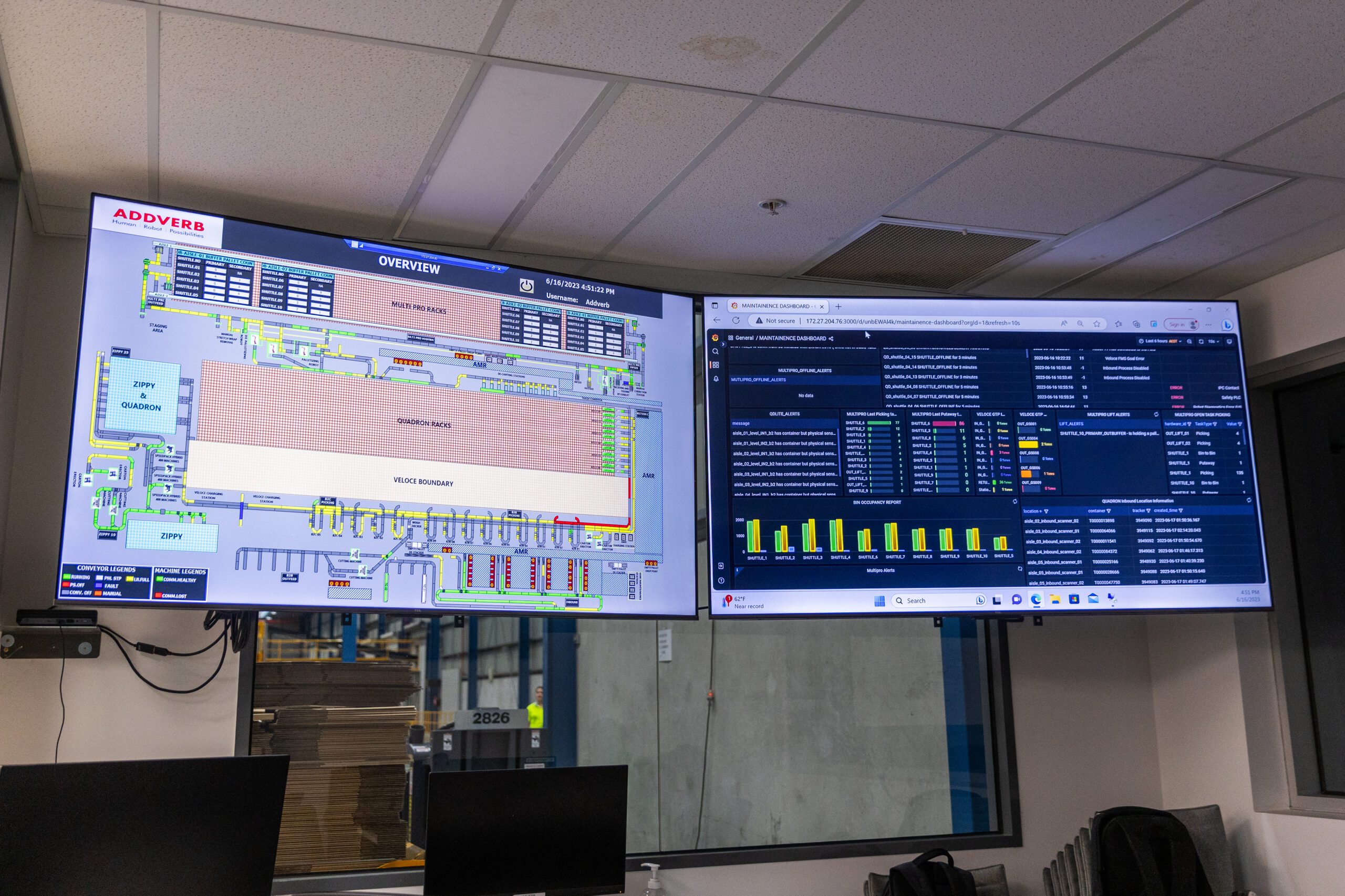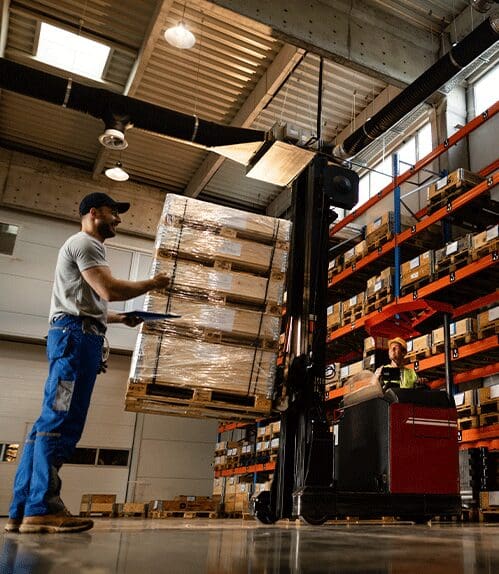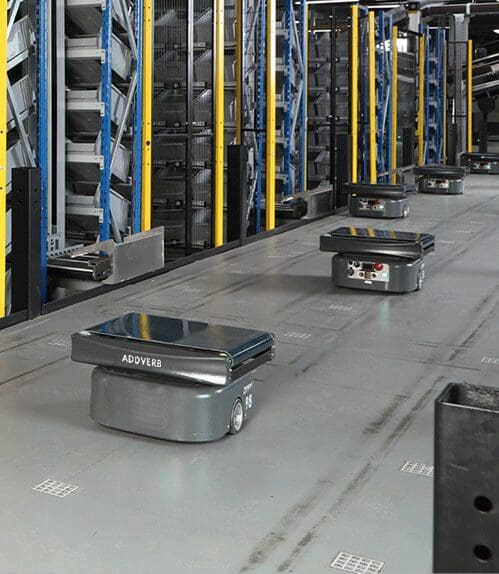Table of Contents
A Warehouse Digital Twin is a real-time simulation of a warehouse that accurately represents the physical characteristics of the building and its system, including digital representations of the building’s infrastructure, the physical and automated material handling systems, the inventory, robots, and all the other interacting components.
It connects to the data streams from IoT devices, Warehouse Management Systems (WMS), and other sources to incorporate aspects of the real world. By doing so, it allows organisations to identify performance improvements without risking downtime or unwanted disturbances, which ultimately improves efficiency and supports decision-making across warehouse operations.
This blog will describe the main advantages, use cases, and consequences for end users of the integration of Digital Twins into the management of warehouses.
What is Digital Twin?
Digital Twin is a replica of a physical object, system, or process and is in real-time. In the context of warehouses, it entails the development of a virtual model of the whole warehouse including the storage systems, MHE, and people. This virtual model is then updated with data from sensors, IoT devices, and other sources so that it is a real-time model.
Benefits of Digital Twin in Warehouses
Enhanced Operational Efficiency
Digital Twins enable one to test different operations virtually before using them in the real-life warehouse. This capability involves the identification of the most efficient processes and a timely optimization of a process to avoid congestion or non-productive time.
Predictive Maintenance
Digital Twins can determine when a machine is likely to develop a fault or when it is due for a checkup because the status of equipment is constantly observed. This predictive ability minimizes unwanted or unexpected equipment breakdowns and increases the life expectancy of the equipment used in the warehouse; in effect, this lessens maintenance costs in the long run.
Improved Inventory Management
Digital Twins give a real-time view of inventory status, where it is, and where it is going. This increased exposure results in increased accuracy in inventory count, fewer instances of stock-outs, and improved space usage.
Cost Reduction
Depending on the optimization of resources, energy consumption, and waste, Digital Twins provide considerable cost benefits to warehouses. This way businesses can choose between various layout designs and operating strategies that would be most effective in cutting costs without having to shut down operations temporarily for alterations to be made.
Enhanced Decision-Making
Since simulation allows managers to see how different scenarios influence the outcome, warehouse managers are in a better position to make informed decisions. Digital Twins also offers predictions on how changes in processes may affect the business objectives and enable the managers to implement the right strategies for the improvement of productivity and minimization of the risks.
Key Components of Digital Twin Technology in Warehouses
Physical Assets: These are the tangible components of the warehouse, such as storage racks, conveyor belts, and robotics.
Digital Model: This is the virtual representation of the physical assets and processes.
Real-Time Data: Collected through sensors, RFID tags, and other IoT devices, providing continuous updates on the status and performance of warehouse components.
Connectivity: The communication infrastructure that facilitates the seamless exchange of data between the physical and digital entities.
Analytics and Simulation Tools: Software tools that analyze the data to provide insights and predictive analytics for optimization.
Practical Applications of Digital Twins in Warehousing
Warehouse Design and Layout Optimization

Digital Twins are particularly useful during the planning and designing of a warehouse. Essentially, through layout planning and simulation of material flow, organizations can determine the layout that best fits their space layout and at the same time, the one that requires the least amount of movement from the workers and equipment.
Simulation of Operational Scenarios
In the warehouses, before actually applying changes, for instance, integrating new automation tools or modifying storage structures, companies can apply Digital Twins. This success minimizes disruptions and brings about the adoption of new processes in organizational procedures.
Training and Skill Development
Digital Twins can be used in training since it allows the workers to train virtually before they move to the actual warehouse. This does not only lead to safety improvement but also increases the skills of the employees and thus productivity.
Real-Time Monitoring and Control
Digital Twins help to monitor the condition of the equipment used in the warehouses and the overall status of the warehouses; stock availability; and the performance of the employees constantly. This information can then be utilised to make changes to the specific operation as and when needed to allow for the best possible performance at all times.

End Note
Digital Twins represent a powerful tool for modern warehouses, offering a range of benefits that extend from operational efficiency to enhanced customer satisfaction. As the technology continues to evolve, its applications and impact are likely to expand, making it an essential component of future warehouse strategies.
The integration of Digital Twin into warehouse operations translates into faster order fulfilment, higher accuracy in order picking, and a more responsive supply chain. The predictive capabilities of Digital Twins ensure that products are available when needed, reducing the likelihood of delays. Additionally, the cost savings achieved through optimized operations often result in more competitive pricing for end consumers.
FAQ
What is a Digital Twin in warehouse operations?
It is a virtual replica of physical warehouse operations, enabling real-time monitoring, simulation, and optimization.
How does it benefit warehouse efficiency?
It enhances efficiency by providing real-time insights, predicting potential issues, and optimizing workflows and resource allocation.
What are the key applications of Digital Twin technology in warehouses?
Key applications include inventory management, predictive maintenance, layout optimization, and process simulation.
How does it help in cost reduction?
It reduces costs by minimizing downtime, optimizing resource usage, and enabling proactive maintenance, which prevents costly disruptions.
Can technology improve decision-making in warehouses?
Yes, it supports better decision-making through real-time data analysis, scenario simulation, and predictive analytics.
What impact does a Digital Twin have on warehouse automation?
It enhances automation by providing a digital environment to test and optimize automated systems before physical implementation.
How does Digital Twin technology affect inventory management?
It improves inventory accuracy, optimizes storage, and reduces excess stock by simulating different inventory scenarios.
Are there any challenges in implementing a Digital Twin in a warehouse?
Challenges include the initial cost, data integration complexities, and the need for specialized skills to manage and interpret the technology.
What are the long-term benefits of using a Digital Twin in warehouses?
Long-term benefits include sustained efficiency improvements, cost savings, enhanced scalability, and continuous process optimization.
How does a Digital Twin impact the end users of a warehouse?
End users experience faster processing times, higher order accuracy, and improved overall service quality due to the optimized warehouse operations enabled by Digital Twins.
Founded in 2016, Addverb offers complete robotics solutions for warehouse and industrial automation, with a strong global presence through its subsidiaries worldwide. The company provides a range of in-house automation products, including Autonomous Mobile Robots, ASRS, and sorting technologies. It serves over 350+ clients, including well-known companies such as Coca-Cola, Amazon, and DHL.






